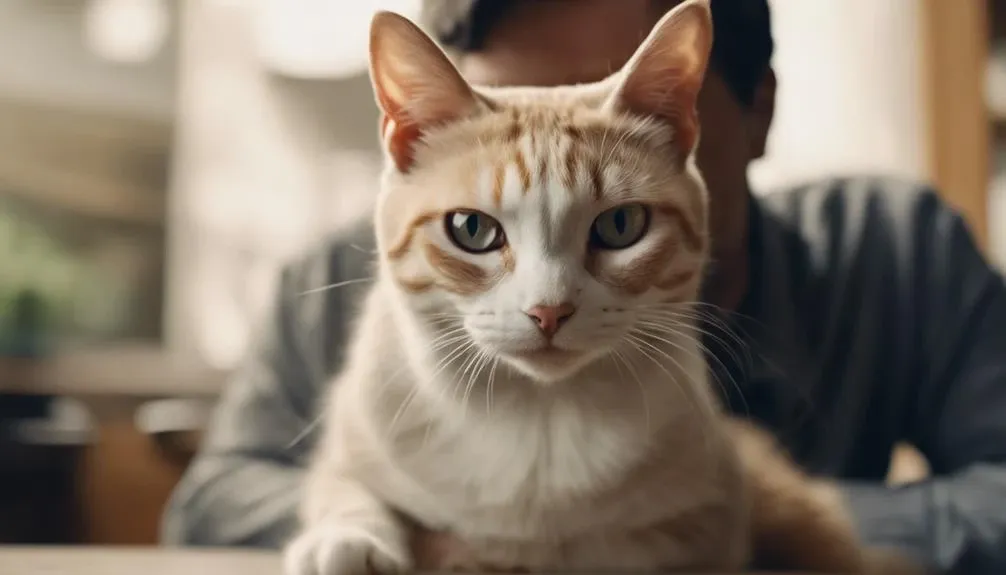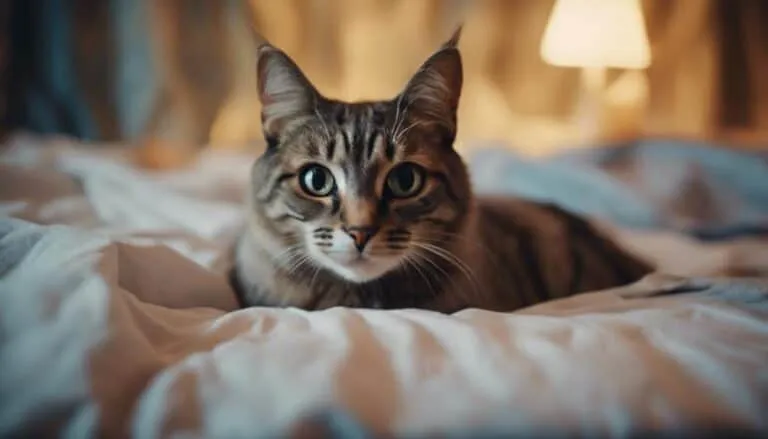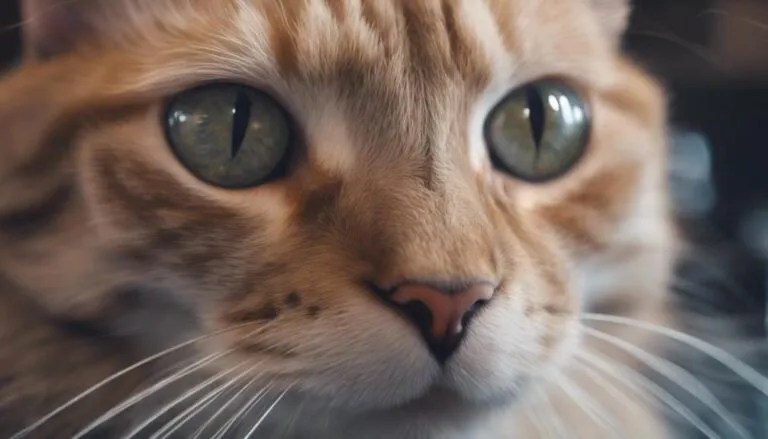The Best Fluffy Pancakes recipe you will fall in love with. Full of tips and tricks to help you make the best pancakes.

You may have noticed your cat's tail swishing or their ears twitching, but do you truly understand what they're trying to convey? Deciphering your feline friend's body language can be a fascinating journey into their world of communication.
By mastering these subtle signals, you'll not only strengthen your bond with your cat but also ensure a deeper connection based on mutual understanding.
Let's explore the nuanced ways your cat speaks to you through their body language and unravel the mysteries behind their gestures and expressions.
Key Takeaways
- Tail position, ear movements, eye expressions, and whisker behavior provide insights into your cat's emotions and needs.
- Decoding tail movements, ear positions, eye signals, and whisker behavior helps in understanding your cat's mood.
- Monitoring raised tails, forward ears, slow blinks, and whisker behavior aids in building a stronger bond with your cat.
- By analyzing tail, ear, eye, and whisker cues, beginners can enhance communication and connection with their feline companions.
Key Cat Body Language Cues
When observing your cat's body language, key cues such as tail position, ear movement, eye expressions, and whisker behavior can provide valuable insights into their emotional state and needs.
The position of a cat's tail is a crucial indicator of their emotional state. A high, vertical tail typically signifies confidence, while a low tail can indicate fear or anxiety.
Ears also play a significant role in cat body language. Forward ears often signal confidence or engagement, whereas ears turned back may suggest anger or fear.
Looking into your cat's eyes can offer further clues. Slow blinking is a sign of trust, dilated pupils can indicate stimulation or fear, and round or partially closed eyes often show contentment.
Additionally, observing your cat's whiskers can provide subtle hints about their mood. Fearful cats tend to keep their whiskers close to their face, while confident cats may push them forward.
Understanding these key cat body language cues can help you better understand your feline friend's emotions and needs.
Understanding Tail Movements
When observing your cat's tail, pay attention to its position and movements.
A raised tail often indicates alertness, while twitching can signal agitation or restlessness.
Understanding these tail movements can provide valuable insights into your feline companion's mood and behavior.
Tail Raised = Alertness
Raising its tail, your cat signals alertness and a keen awareness of its surroundings, offering valuable insights into its state of mind.
When your cat holds its tail up high, it's expressing curiosity or excitement. Understanding tail movements, like quivering or flicking, can provide further clues about your cat's emotions.
Tail Twitching = Agitation
With tail twitching being a common behavior in cats, it serves as a crucial indicator of agitation, alertness, or excitement depending on the specific context. The speed and intensity of the tail twitching can offer valuable insights into your cat's emotional state. When a cat is agitated, the tail movements may be swift and erratic, often accompanied by other body language cues like flattened ears or dilated pupils. It is essential to consider the overall body language of your cat when interpreting tail twitching behavior to get a more accurate understanding of their level of stimulation or stress. By observing these subtle cues, you can better respond to your feline companion's needs and ensure their well-being.
| Tail Twitching | Emotional State | Interpretation |
|---|---|---|
| Slow and Gentle | Content or Relaxed | Indicates relaxation or happiness. |
| Fast and Erratic | Agitated or Stressed | Signals potential distress or discomfort. |
| Intermittent Twitching | Alert or Excited | Shows heightened awareness or anticipation. |
Decoding Ear Positions
When observing your cat's ear positions, note that ears pointed forward typically indicate alertness. Ears flattened backward may signal a defensive stance. Additionally, twitching ears could be a sign of nervousness or curiosity in your feline companion.
Understanding these subtle cues can offer valuable insights into your cat's emotional state and overall well-being.
Ear Forward: Alertness Signal
Engage with your cat's state of alertness and engagement by decoding the positions of their ears. When your feline friend's ears are forward and upright, it signifies alertness and a high level of engagement with their surroundings.
Here are some key points to help you understand this ear position:
- Forward ears indicate your cat is actively listening and showing interest in stimuli.
- It shows a positive and responsive mood, often ready for interaction or play.
- Monitoring ear positions can reveal your cat's level of focus and awareness.
- Recognizing the signal of alertness through ear positions can deepen communication and strengthen the bond with your cat, facilitating a better understanding of their needs and emotions.
Ear Backward: Defensive Stance
Deciphering your cat's body language becomes crucial when their ears are positioned backward, signaling a defensive stance or feeling of being threatened. When a cat's ears are tucked back or down, it may indicate that they are in a defensive or angry mood. This defensive stance, often accompanied by other signs like constricted pupils, tail thrashing, or hissing, suggests that your cat is not in a welcoming emotional state. Understanding these ear positions can help you interpret your cat's potential reactions accurately. Below is a table summarizing the key points to look for when trying to understand your cat's defensive or aggressive behavior:
| Key Points | Description |
|---|---|
| Defensive Stance | Ears positioned backward signal a defensive or threatened emotional state. |
| Feeling Threatened | Tucked-back ears often indicate that the cat is feeling threatened or angry. |
| Aggressive Mood | Backward ears, along with other signs, may signify an aggressive mood. |
| Interpretation | Understanding ear positions helps interpret potential reactions accurately. |
Ear Twitching: Nervous or Curious
As you observe your cat's ear twitching, you can gain insights into their feelings of nervousness or curiosity in various situations. Cats use ear twitching as a form of communication to express their emotional state.
Here are some key points to help you understand your cat's ear twitching better:
- Ear twitching can indicate nervousness or uncertainty.
- Cats may twitch their ears when they're curious about something.
- Rapid ear twitching can signal heightened alertness.
- Understanding ear positions alongside other body language cues provides a comprehensive view of your cat's feelings.
Interpreting Eye Expressions
When observing your cat's body language, interpreting their eye expressions can provide valuable insights into their emotions and needs. Cats use their eyes to communicate a range of feelings, from trust and comfort to excitement or fear. Slow, steady blinks indicate a sense of security and contentment, while dilated pupils may signal heightened emotions like excitement or fear. Conversely, tiny pupils often suggest relaxation and happiness. Understanding these eye signals is crucial for deepening your bond with your feline companion and responding appropriately to their needs.
| Eye Expression | Meaning |
|---|---|
| Slow Blinks | Trust and comfort |
| Dilated Pupils | Excitement or fear |
| Tiny Pupils | Contentment or relaxation |
| Varied Eye Signals | Communication of emotions |
Significance of Whiskers
Upon observing your cat's body language, the significance of their whiskers becomes evident as these highly sensitive touch receptors play a crucial role in their navigation and communication within their environment.
Here are some key points to understand the importance of your cat's whiskers:
- Navigation Aid: Whiskers aren't just facial hair; they're vital touch receptors that help your cat detect changes in air currents. This ability aids them in hunting and avoiding obstacles effectively.
- Mood Indicator: The position of your cat's whiskers can be a good indicator of their mood. When whiskers are pushed forward, your cat might be curious, while pulled back whiskers could signal fear or anxiety.
- Avoid Cutting: Cutting a cat's whiskers can have severe consequences. It can disorient them, affect their ability to communicate, and lead to stress and discomfort.
- Essential for Well-being: Healthy whiskers are crucial for your cat's well-being. They should never be trimmed or tampered with as they play a significant role in your cat's daily life and interactions.
Deciphering Vocalizations
Deciphering your cat's vocalizations provides valuable insight into their needs and emotions, allowing you to better understand and respond to your feline companion. Cats employ a diverse range of vocalizations to communicate, including meowing, purring, hissing, growling, and yowling. Meowing serves various purposes such as greeting, seeking attention, expressing hunger, or indicating distress. It's essential to pay attention to changes in your cat's meowing patterns, as excessive meowing can signal underlying health issues, stress, or a need for companionship or food.
Purring is a common vocalization associated with contentment, relaxation, or healing. On the other hand, growling and hissing are defensive vocalizations that cats use to convey aggression, fear, or discomfort in specific situations. Yowling may indicate pain, mating behavior, or territorial disputes. Understanding these vocal cues can help you interpret your cat's emotions and address their needs effectively. By listening to and observing your cat's vocalizations in conjunction with their body language, you can build a stronger bond with your feline friend.
Putting Signals Together
To better understand your cat's emotions and needs, combining tail position, ear movements, and eye expressions is essential. By observing these key aspects of your cat's body language, along with their body posture and the context of the situation, you can gain valuable insights into what your feline friend is trying to communicate.
Here's how you can put these signals together effectively:
- Tail Position: A tail held high indicates confidence and happiness, while a low or tucked tail may signal fear or insecurity.
- Ear Movements: Forward-facing ears suggest alertness and interest, while flattened ears could indicate aggression or discomfort.
- Eye Expressions: Dilated pupils may show excitement or fear, while slow blinking can signal contentment and trust.
- Body Posture: A relaxed and open body posture generally indicates comfort, while a tense or hunched stance might suggest unease or defensiveness.
Enhancing Cat-Human Bond
Understanding your cat's body language is a crucial step in fostering a strong and deep bond between you and your feline companion. By learning to read your cat's body language signs, you can better understand how your cat feels and respond accordingly.
The Humane Society suggests paying attention to cues such as flattened ears, dilated pupils, twitching tail, and whisker positions to gauge your cat's emotions. When your cat is happy, you may notice relaxed body language, purring, and slow blinking. Conversely, a scared cat may exhibit signs like a tucked tail, wide eyes, and flattened ears.
Engaging in activities that your cat enjoys, like providing a cozy spot for them to relax or giving gentle belly rubs when they solicit attention, can strengthen your bond. Understanding your cat's body language not only deepens your connection but also ensures a more fulfilling relationship based on trust and mutual understanding.
Frequently Asked Questions
How Do You Decode a Cat's Body Language?
To decode a cat's body language, notice playful gestures, content purring, relaxed posture, tail flicks, kneading behavior, slow blinking, vocal cues, stretching movements, and aggressive signs. Understanding these cues fosters a deeper connection between you and your feline friend.
What Is a Cat Friendly Body Language?
When observing a cat's body language, look for signs of playfulness like playful antics, relaxed posture, and slow blinking. Friendly greetings may include ears forward, purring contentment, kneading behavior, meow variations, and a tail in a neutral position.
How Do You Understand What My Cat Is Saying?
To understand what your cat is saying, observe cues like vocal expressions, tail movements, ear positions, eye contact, purring behavior, body postures, facial expressions, and playful gestures. This helps decipher their emotions and strengthens your bond.
What Is a Cat's Body Language When They Are Scared?
When your cat is scared, watch for flattened ears, dilated pupils, hissing, growling, tail tucked, arched back, crouching low, avoiding eye contact, rapid breathing, and hair standing up. These signs indicate fear or anxiety.
Conclusion
In conclusion, mastering the art of reading your cat's body language is vital for strengthening your bond and meeting their needs effectively.
By honing in on key cues like tail movements, ear positions, and eye expressions, you can better understand your feline friend's emotions and intentions.
Pay attention to the subtle signals they give off, and you'll be well on your way to fostering a harmonious relationship filled with trust and communication.








